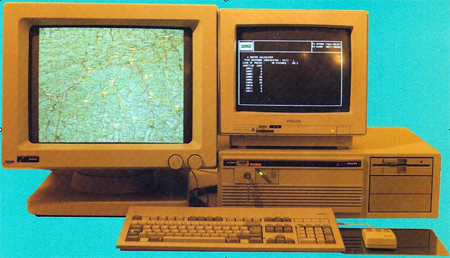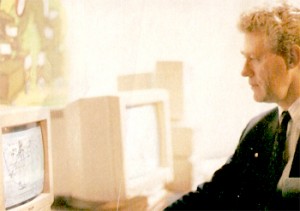Celebrating the Birth of Cincom Smalltalk, Part 2
Do you remember 1999? Were you still in grade school? College? Perhaps you were already working at Cincom. As you reflect back to your personal journey in 1999, let us take you on a journey of two products that eventually found their way to the doorstep of Cincom Systems, Inc.
Later this year, we will be celebrating the 20th anniversary of Cincom Smalltalk here at Cincom. Although our beloved object-oriented programming language has been around since before 1970, it wasn’t until late 1999 that Cincom brought ObjectStudio and VisualWorks together under the umbrella of Cincom Smalltalk. To read more about the early years of Smalltalk that we wrote about last month, click here.
The Dramatic Birth of ObjectStudio
The year 1989 was a significant year in world history, with several important and memorable things that would impact our global society. In March of that year, the super-tanker, Exxon Valdez, ran aground in Prince William Sound, Alaska, causing the worst oil spill in US history. In April, US troops brought down the Noriega regime in Panama, and later that year the tragic events in Tiananmen Square, China took place. Besides these, additional social and political events were spawning all over Europe as the winds of change and reform were blowing across the continent.
October of that year had some notable events, namely the 6.9 major earthquake that hit in San Francisco during Game 3 of the World Series. Across the pond, among the political change happening in Europe, the predecessor of ObjectStudio was born. Here is that story:
HSA (Hollandse Signaalapparaten, the military division of Philips) was developing complex decision support systems for the navies around the world. The general name for that kind of system was C3I (Command Control Communications Intelligence). C3I supported decision-making for the usage of weapons like missiles, guns and torpedoes, based on information achieved and filtered from radar and sonar sensors, as well as optical devices. These systems were huge and complex, the software was tailor-made and all the components were assembled on one platform like frigates and corvettes. Around 1985, HSA decided to consider the possibility to also develop C3I-systems for the army.
In contrast to the navy, the army had a great number of platforms. An artillery observer and radio telegrapher formed one platform. With a military map, binoculars and a measurement device, the observer would make crucial decisions and send that information to other groups. Jeeps, tanks and other vehicles in a command center were considered another platform. The army had, until now, very little experience with computerized decision support systems. Of course there were written procedures to coordinate the actions. However, to achieve this type of procedure on a computer, a development system was needed that made interactive prototyping possible. This would ultimately allow an efficient decision support system to become a reality. The development system must be created with the newest generation of PCs having sufficient speed and memory and an operating system that supports multi-programming with a generally accepted graphical user interface (GUI).
In 1987, there was an announcement by Microsoft and IBM of a multi-programming operating system (OS/2) that included a GUI called Presentation Manager. This seemed to conform with the required preconditions.
 A software company named ENFIN already had a working knowledge of these types of requirements. A trial demonstrating an Artillery Planning System proved the possibilities of their existing software. Instead of the calculated 4000 man-hours, the trial only took 1000 man-hours. This led to a joint venture between HSA and ENFIN, aiming to transform all the software within the OS/2 and Presentation Environment to Smalltalk. As a control, the whole development requirements were defined for four decision support prototypes.
A software company named ENFIN already had a working knowledge of these types of requirements. A trial demonstrating an Artillery Planning System proved the possibilities of their existing software. Instead of the calculated 4000 man-hours, the trial only took 1000 man-hours. This led to a joint venture between HSA and ENFIN, aiming to transform all the software within the OS/2 and Presentation Environment to Smalltalk. As a control, the whole development requirements were defined for four decision support prototypes.
Near the end of 1989 at a computer exhibition in Vienna, the first Smalltalk-based prototype application was shown. This prototype was not yet based on OS/2 and the Presentation Manager. Similarly, a frequency management system was presented in Berne, Switzerland a few days later.

Then in October, SCOPE (Signaal’s Command Oriented Programming Environment) was demonstrated at the AFCEA Conference in Brussels. This new development system, based on OS/2 and the Presentation Manager, included a number of prototypes. Based in Smalltalk and oriented with OS/2 and Presentation Manager, SCOPE was a 4GL object-oriented development system offering a large number of services for the specification, realization and maintenance of Management Information Systems in particular.
By introducing this development system, SCOPE achieved the following:
- It was the first object-oriented development system on a PC.
- It became the first GIS (Geographical Information System) on a PC.
- The positive effects of EPM (Evolutionary Prototyping Method) combined with the EPIS (Evolutionary Procurement of Information Systems) methodology was proven (EPIS ’90 symposium in The Hague).
- The combination of Smalltalk and EPM was superior in relation to the traditional way of programming (as was usual in the military sector with a language like Ada).
- The notion that the military could use civil components indicated what the term COTS (Commercial off-the-shelf) would become.
However, the tremendous opportunities of SCOPE were overshadowed by an enormous political event a month later. On November 9, 1989, the obligations of NATO to defend its allies against communism ended with the Berlin Wall crumbling to the ground. Because of this, the Dutch army was no longer interested in SCOPE. It would be several years before there would be interest in a command control system again.
ObjectStudio saw a number of owners during its life cycle. After the release mentioned above, a contract was made between HSA and ENFIN to distribute the market. For HSA, they owned the rights to the military market and Philips. ENFIN could sell the product everywhere else.
Eventually, several mergers would give Cincom Systems, Inc. the rights for development and marketing of ObjectStudio, preceded by ENFIN, EASEL and VMARK. Throughout its infancy, the name of the product changed often. Names like SCOPE, Enfin/2, EASY and ObjectStudio saw the light. But eventually, SCOPE became Cincom® ObjectStudio®.
To see Cincom ObjectStudio’s history in its entirety, click here.
